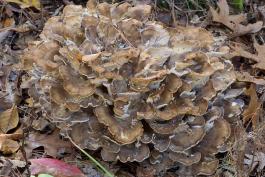
Large circular cluster of spoon-shaped caps; grayish brown on top and white beneath; single, branching, whitish base. Grows on the ground at the base of oak trees. September–November. Each cap spoon- or fan-shaped; grayish to gray-brown to brownish. Pores angular; white to yellowish. Stalk short; branching; white. Spore print white. Spores magnified are elliptical, smooth.
Lookalikes: Black-staining polypore (Meripilus sumstinei) blackens when bruised or handled. Berkeley’s polypore (Bondarzewia berkeleyi) is thick-fleshed and cream-colored. Eastern cauliflower mushroom (Sparassis spatulata) has ribbonlike folds. Remember that hen of the woods is a pore fungus (polypore) and lacks gills.
Cluster width: to 3 feet; weight: 5-10 pounds (often up to 50 pounds); cap width: ¾–3 inches.

Statewide.
Habitat and Conservation
Grows as a single large circular cluster on the ground at the base of oak trees or stumps. Common in hardwood forests with mature and aging trees, particularly in moist woodlands and in river bottoms, where there are plenty of mature and aging trees. It is often found on the same tree year after year, so check your spot every autumn.
Status
A choice edible, and also considered a medicinal mushroom. This not only is a deliciously choice mushroom, but also is known to have many health benefits, including support for the immune system and improvements in blood pressure, blood sugar, and cholesterol levels. This can be quite a large mushroom—harvest what you need and leave the rest to continue growing. Use only fresh, tender portions. Simmer slowly in salted water until tender. Hen of the woods makes a hearty and meaty mushroom soup.
Life Cycle
This species lives as a network of cells (mycelium) within dead trees as a saprobe, and living trees as a parasite, digesting and decomposing the wood. When ready to reproduce, the mycelium develops the “henlike” reproductive structure that emerges from near the base of the tree. Spores are produced in pores on the undersides of the caps and are released to begin new mycelia elsewhere.
Human Connections
A delicious edible mushroom. In Asia, it has been used medicinally for centuries. Called “maitake” in Japan, a name that means “dancing mushroom” — because people dance for joy when they find it. It is often available in international groceries. Researchers are exploring its medicinal potential.
Ecosystem Connections
Fungi are vitally important for a healthy ecosystem. This fungus feeds on dead or dying trees, decomposing them as they go. This cleans the forest and helps nutrients to cycle back into the soil — an unglamorous but vital role in the ecosystem.






Mushrooms are a lot like plants, but they lack chlorophyll and have to take nutrients from other materials. Mushrooms are neither plants nor animals. They are in a different kingdom — the fungi. Fungi include the familiar mushroom-forming species, plus the yeasts, molds, smuts, and rusts.
Always be cautious when eating edible mushrooms. Be absolutely sure of the ID, and only eat a small amount the first time you try it to avoid a reaction..





















